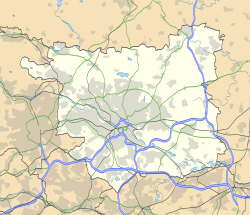 Old quarry, Bramley Fall Park | |
| Location | |
|---|---|
The quarry's position in Leeds | |
| Location | Near Horsforth Leeds |
| County | West Yorkshire |
| Country | England |
| Coordinates | 53°49′22″N 1°37′26″W / 53.82278°N 1.62389°W |
| Production | |
| Products | Millstone Grit |
| History | |
| Discovered | 13th century |
| Closed | c. 1930 |
| Owner | |
| Company | B. Whitaker and sons, 4 Albion Street, Leeds in 1927 |
Bramley Fall Stone belongs to the Millstone Grit series, of the Namurian stage of the Carboniferous Period. It is one of the cheapest and best-adapted English stones for extensive engineering works, docks, locks and railways, and for large millstones, grindstones, engine-beds and foundations. The stone was formerly quarried at or near the village of Bramley, Leeds. Evidence of the quarries, which were discontinued around 1930, remain in Bramley Fall Park. A similar Millstone Grit stone also occurs over an extensive area at Calverley where Ann Husler ran a quarrying business in the 19th century, and at Ilkley and Pateley in Yorkshire. A somewhat similar stone, which can be very coarse, approaching a conglomerate is found at Weetwood, Meanwood and Horsforth. Similar Millstone Grits have also been quarried in Derbyshire.[1]
- ^ "Building stone quarried at Bramley, England". Powerhouse Museum. Retrieved 7 December 2020.
